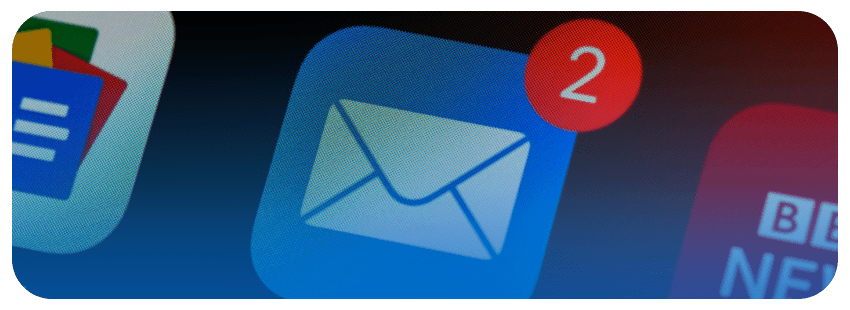I’m sure you already know how important and powerful email marketing is. Well, using drip campaigns will take your email marketing strategy to a whole new level.
The problem with your weekly newsletter is that it’s only sent out every week. If a new subscriber joins your mailing list, the first message they receive is your standard email blast that everyone else also receives at the same time.
You can personalize this more, give your new subscribers a proper welcome, and make sure that everyone who joins your mailing list receives your most important content.
This is why you need to use drip marketing.
Whether you’re an online store trying to ramp up sales, or a service business looking to warm up new leads, drip campaigns will become your new best friend.
Keep reading to find out what exactly a drip campaign is, what types of drip campaigns you can send, and how to set up your own drip campaign step-by-step.
- What is a Drip Campaign?
- Why Use Drip Campaigns?
- How Your Business Can Use Drip Campaigns
- Drip Campaign Ideas and Examples
- How to Set Up a Drip Campaign
What is a Drip Campaign?
A drip campaign, or drip marketing, is when you send out a series of automated messages to your audience based on certain actions.
Drip campaign emails can be triggered by pre-determined time periods, actions that the recipient takes, interactions with your website, or other factors.
A business can use a drip campaign to automatically stay in touch with leads and customers in a personalized and targeted way. Drip campaigns are sent out when the lead or customer takes an important action, allowing you to reach them with the right content at the right time.
They’re called drip campaigns because they refer to emails that are sent out slowly and consistently.
These emails are prewritten and automated. You can choose how many messages form your drip sequence – it could be 2, it could be 10, or any other amount.
Here’s a very basic example of how an email drip campaign works:
- A new subscriber signs up for your email list and they are sent a welcome email with a CTA
- If they click on the CTA, they are sent email 1. If they do not click on the CTA, they are sent email 2
- Email 1 also has a CTA. If they click it, they are sent email 3. If they do not click on it, they are sent email 4. Email 2 has a CTA as well. If they click email 2’s CTA, they are sent email 1. If they do not click it, they are sent email 4.
Make sense?
This is just a basic framework for how an email drip campaign works, but you could have many more options. You can make drip campaigns as complex or as simple as you like. The important thing is that they are predesigned, and then automated.
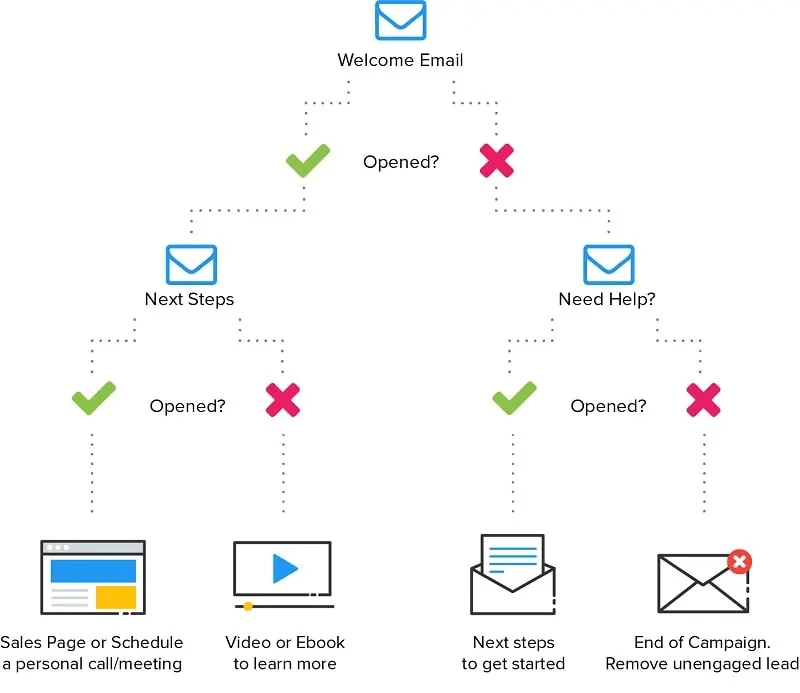
Why Use Drip Campaigns?
Drip campaigns can help any kind of business achieve many different goals.
You could increase sales by steadily converting new leads into customers. You can keep your audience engaged and build stronger relationships with them. Drip campaigns could help you to increase repeat purchases, recover lost purchases, reengage your audience, and more.
Whatever the goal of your campaign is, the main idea behind drip campaigns is that they help you strategically stay in touch with your audience without having to invest time or effort into each individual correspondence.
Here are four of the main advantages of drip campaigns, no matter what you’re using them to achieve:
Time-Saving Automation
The great thing about sending drip campaigns is that you set them and forget them. Once you’ve crafted your messages, you add your triggers and leave the automation sequence to do the work.
This lets you perfectly control email communications for as many people as you want. Your emails will always reach the right person at the right time, without you having to worry about sending them.
This makes running your business more efficient, it saves time, and it makes your operations a lot easier to scale.
Highly Targeted
Because a drip campaign has to be triggered by a specific action or event, this means you can make these email sequences incredibly targeted.
If someone purchases a certain product, send them an email sequence related to that product. If someone enters a giveaway, send them an email sequence related to the giveaway prize.
Instead of just blasting your list with a generic email, drip sequences let ou target specific users with specific content.
Lead Nurturing
Drip campaigns are the ideal way to nurture leads. Drip sequences are commonly used to warm up and engage with cold prospects.
If you send out a cold email to a prospective customer, don’t let that be the last email you send out. Otherwise, they will soon forget about you.
Instead, hit them with a few follow-up emails. This gives you more opportunities to interest and engage the lead, share interesting content with them, and move them down your funnel.
You can also apply this idea to existing customers, not only new prospects. Drip marketing campaigns let you maintain and grow your relationship with them. By sending out drip campaigns, you can remain top-of-mind and continually motivate your customers to make new, repeat sales.
Check our guide on how to create email drip campaigns to nurture leads for more information on this.
Send Information at the Right Time
The beauty of automated drip campaigns is that they make sure you send the right information to the right person at the right time.
You set up your drip marketing campaign so that only people who perform a certain action are sent information that relates to that action. This information is delivered during the exact step in the sales cycle that matches the information.
Basically, this means your audience receives relevant and more personalized, communications at whatever stage they are.
How Your Business Can Use Drip Campaigns
Drip campaigns are automated emails, designed to send a targeted message to someone at the right time. This means you can use drip campaigns to achieve all kinds of things, while you focus on managing other aspects of your business.
Because you can customize and personalize drip marketing campaign sequences, there are limitless ways that you can use them.
You could trigger these messages by dates, time, actions, or more, to ensure you send out unique, powerful marketing messages that achieve results.
Here are a couple of ways that you can use drip campaigns.
Trigger Drip Campaigns Based On Dates
One way to set up marketing automation sequences is to deliver them based on time periods or dates. Here are a few examples of this:
- Date-based automations: Send emails on important dates that matter to your subscribers, like their birthday or a year after their first purchase.
- Subscription prompts: Automatically notify customers before their subscription is up. This is important for enticing them to renew their subscription.
- Time-based automations: If a customer hasn’t received any communications in a while, you could send an automated message just to keep them in the loop. You can also spread out messages over time to ensure you maintain engagement.
Trigger Drip Campaigns Based On Behavior
You could also trigger an email drip campaign based on the actions, or behavior, that a user takes. Here are some examples of this:
- Interest-based drip sequences: Send relevant, personalized content based on actions a user takes. For example, if they sign up through a specific landing page, send them content that relates to that landing page topic. If they bought a product, send them messages that relate to their purchase.
- Transactional emails: Automatic transactional emails include things like sending receipts or shipping updates after a customer makes a purchase.
- Lead nurturing campaigns: Developing interest from leads is a big advantage of using drip campaigns. You can reach out to leads with a series of automated emails based on what actions they took and what interests they show. Set an end goal for the drip campaign, and steadily work your way there by sharing valuable content.
- Send recommendations: If a customer bought a specific product or made a certain request, you can recommend further products or services based on this. For example, if they bought a pair of men’s formal shoes, you could target them with messages promoting men’s formal jackets or pants.
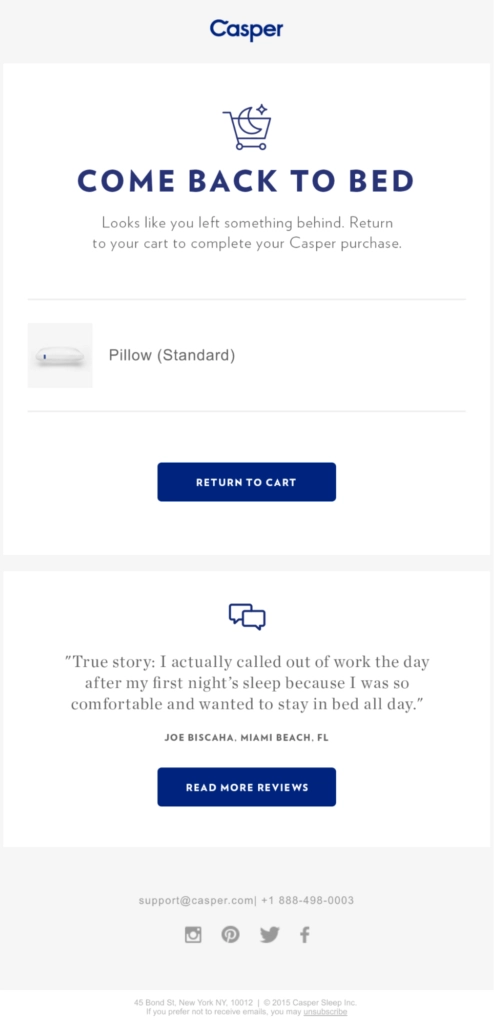
Drip Campaign Ideas and Examples
Here are a few common examples and use cases of automated drip campaigns that all kinds of businesses can use.
1. Welcoming Drip Campaigns
One of the most classic use-cases of drip campaigns is to send an automated welcome email when a new person signs up for your mailing list.
Subscribers expect at least one friendly welcome message to confirm their subscription. This is simple to set up. Although, a good drip marketing campaign will take this further.
You can set up a series of welcome emails to really engage the new subscriber and show them that you care. This also gives you more opportunity to showcase what your brand is all about and what you offer.
After a series of welcome drip emails, the new subscriber will be more comfortable with your brand. They will probably also have more reason to become a customer.
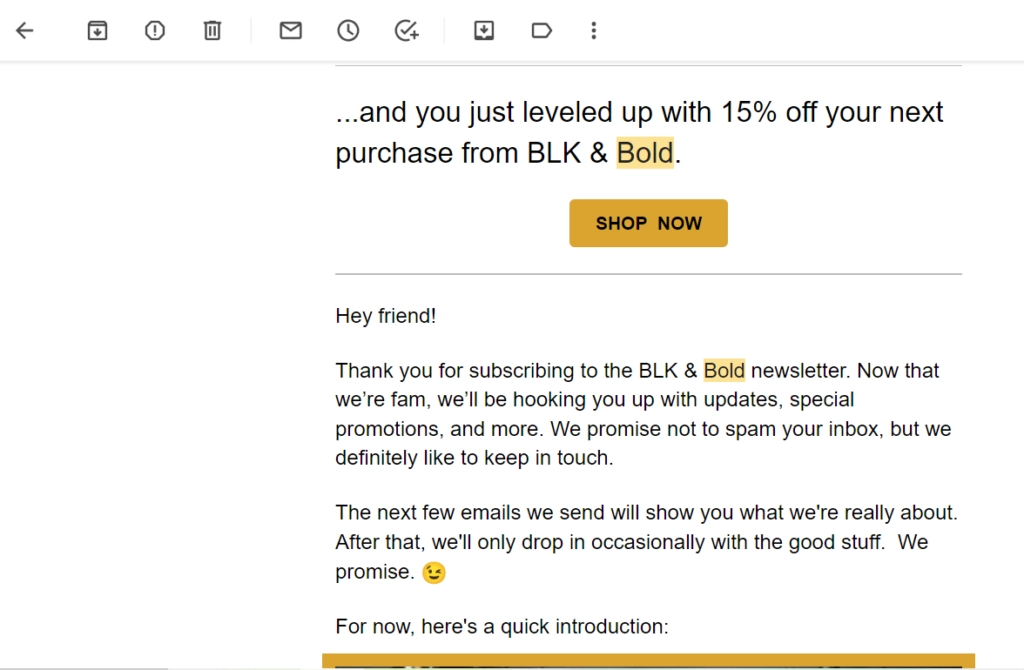
Welcome Drip Campaign Template
For example, let’s say you’re an eCommerce store. You send out a series of 4 welcome drip emails to each new subscriber. Your email drip sequence could look like this:
- Email 1: Introduce your brand and the kind of content the new subscriber can expect. Possibly offer a welcome discount code for their first purchase
- Email 2: Send an email about your brand values or what makes your online store unique. This will help you start to build value for the new subscriber
- Email 3: Showcase a few of your top products and mention why they are special. You could include a discount code again here
- Email 4: Highlight additional benefits about your store, like free shipping perks or your loyalty program. Give the subscriber more reason to make a purchase
From here, you can enter the subscriber into your regular newsletter sequence. This is just one example, but it shows you how you can add more value and offer the subscriber more information through a strategic welcome drip sequence.
2. Re-Engagement Drip Campaigns
Your lead could have gone cold and you haven’t seen any engagement from them in a while. This is when you enter that cold lead into a re-engagement drip sequence.
Your goal is to turn the prospect into an engaged and active customer. So, before the lead slips away, try to re-engage them with a strategic sequence of drip emails.

Re-Engagement Drip Campaign Ideas
How do you re-engage cold prospects? Here are a few proven strategies:
- Send the prospect a discount code
- Send the prospect a special offer, like free shipping or a gift with their first purchase
- Simply say “We miss you” or “Hey, we haven’t heard from you in a while”
- Send the prospect a case study, testimonials, or positive reviews from your customers
Or combine these strategies. Your overall goal is to add an extra boost of value that the prospect just can’t ignore.
3. Top-Of-Mind Drip Campaigns
A top-of-mind automated email campaign is designed to maintain your subscriber or customers’ interest.
You could trigger these email drip campaigns if a customer hasn’t engaged in a while, or you could spread them out to all subscribers to keep everyone up to date.
Your goal is to make sure your subscribers never forget about you. They may not need your product right now, but when they do you should be at the top of their mind.
These campaigns work well when you send out regular content (like blog posts and videos) about your brand. You can remind subscribers about your products, or send limited-time promotions.
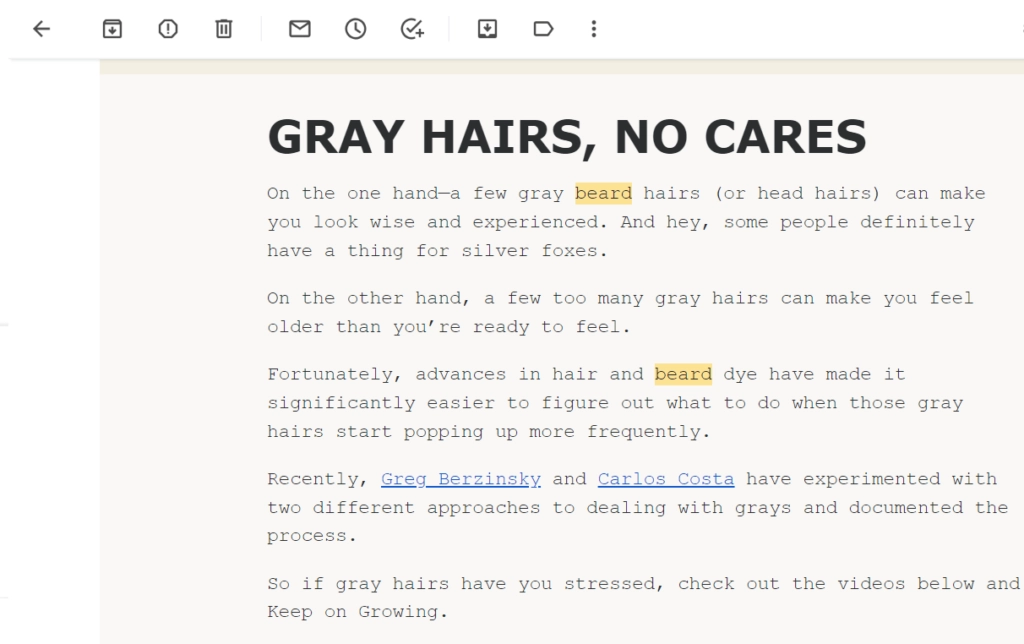
Top-Of-Mind Drip Campaign Template
These types of drip sequences are also often called educational campaigns because they’re all about sharing valuable, interesting content. Your goal isn’t necessarily to drive a purchase (although that would be nice), but it’s to keep your brand visible.
Let’s say you sell shampoo. Here’s how you could run one of these campaigns:
- Email 1: Send an email about scalp conditions, sharing an article on this topic, and why your shampoo will help
- Email 2: Send an email to the same leads sharing a few hair styling tips
- Email 3: Share a video that you made about clients using your shampoo and what kind of results they got from it
- Email 4: Remind your leads about your products and send out a limited-time discount coupon
Just replace shampoo with your product, and swap content on dry scalps and hairstyles with whatever problems your customers are facing.
4. Post-Purchase Follow Ups
You want to show your customers that you care about them. An automated post-purchase follow-up email is one of the best ways to do this.
You can create drip campaigns that trigger after a customer makes a purchase. First, send a confirmation email confirming the purchase. This is essential.
Second, set a time frame (a week works well) and ask them how the product is doing. This shows your customer that you care about their experience, which helps build trust. You can also use this as an opportunity to ask them to leave a review.
If you want, you could include another message promoting cross-sell products that relate to their purchase.
Your goal here is to keep your customers coming back for more. Post-purchase drip marketing campaigns are excellent ways to encourage future purchases.
It can be up to 25 times more expensive to find a new customer compared to retaining existing ones. See why it’s so important to keep your existing customers engaged?
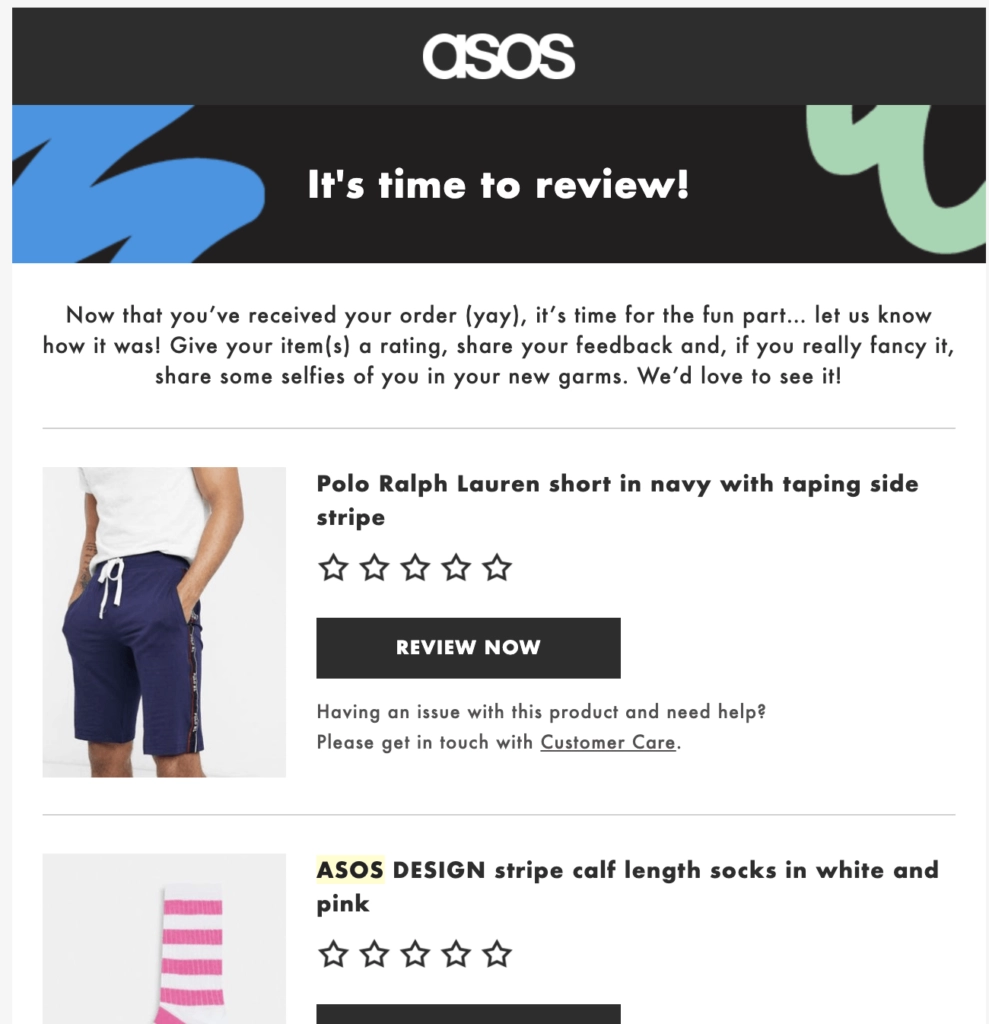
Post-Purchase Follow-Up Drip Campaign Template
This kind of drip campaign is pretty simple and straightforward. You can keep it short with just four messages:
- Email 1: Confirm the purchase as soon as the customer paid. Thank them for their purchase.
- Email 2: Send any relevant shipping information and updates. Let the customer know exactly when they will receive their purchase.
- Email 3: Roughly a week or two after the product was shipped, ask the customer how they are enjoying the product. You could add a link to your review page and ask them nicely to leave a review.
- Email 4: Send new product recommendations based on the product they purchased.
Note: After they made the purchase, the customer should automatically be added to an email list relating to that product (such as male clothing customers or female clothing customers). This lets you target them with relevant content long after the drip campaign has ended.
5. Informational Drip Campaigns
Drip campaign emails are slow and steady. This means they’re the perfect opportunity for you to keep your subscribers up-to-date with your products.
Before you start trying to sell to a new prospect, you could enter them into an informational marketing automation sequence. This is important because people need to know about your product and what problem it solves before they buy it.
Informational drip campaigns also build trust and authority around your brand.

Informational Drip Campaign Template
The first step is to understand your customer’s pain points, questions, or problems. Then, address this through interesting, useful content. Some ideas to send include:
- Informational blog posts explaining your products
- Product videos
- Case studies of your products
- Quick introductions to what your products can do
Whatever content you share, your drip campaign should look something like this:
- Email 1: Top-level informational content (eg “why you need to wear running shoes for a marathon”)
- Email 2: Medium-level informational content (eg “how to choose the right running shoes for your marathon”)
- Email 3: Content with more commercial intent (eg “5 best running shoes for your next marathon”)
- Email 4: Content to try to push a sale (eg “receive a free pair of socks with your first running shoe purchase”)
If you want to focus on more information and less selling, simply extend the number of informational emails until you start hitting the prospect with content that has a greater commercial intent.
6. Promotional Drip Campaigns
What’s one of the easiest ways to ramp up sales? Running a limited-time promotion.
This could include a limited-time discount, a giveaway, a special offer, or more.
Trigger these promotional drip campaigns to send out after a prospect has performed a certain action, or after a certain time period. Making the promotion a limited-time offer increases your chances of fast impulse purchases.
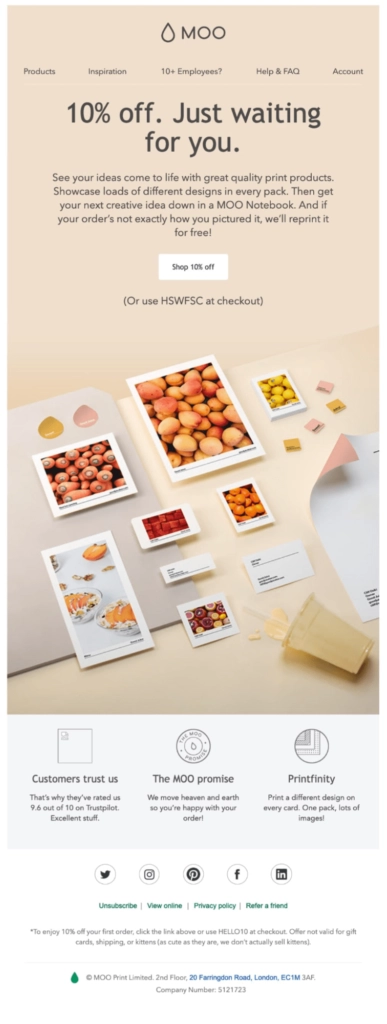
Promotional Drip Campaign Template
Here is a basic overview of how you could run these kinds of drip sequences:
- Email 1: Interest the prospect with interesting information about your product
- Email 2: Now hook the prospect with a limited-time discount code or promotion
- Email 3: Send a testimonial or product video and remind them about their discount
- Email 4: Remind the prospect that their limited-time discount is nearing an end
Then, you could do two things at the end of this campaign. If the prospect made the purchase, add them to a list and hit them with a post-purchase drip campaign sequence. If they did not make a purchase, add them to a different list and hit them with an informational drip sequence.
7. Unsubscribe Drip Campaigns
Unsubscribes are inevitable, and there are many reasons that a person might choose to unsubscribe.
However, when someone hits the unsubscribe button, it’s also your last chance to try to reel them back in.
You could send a final goodbye message confirming the unsubscribe. This message could include a list of additional options for the unsubscriber to take, like only receiving certain emails from you.
Who knows, it could just rope them back in.
This kind of automated campaign will only trigger a single message. If the subscriber chose not to unsubscribe, you could add these renewed subscribers to a new list and target them with a different drip campaign sequence.
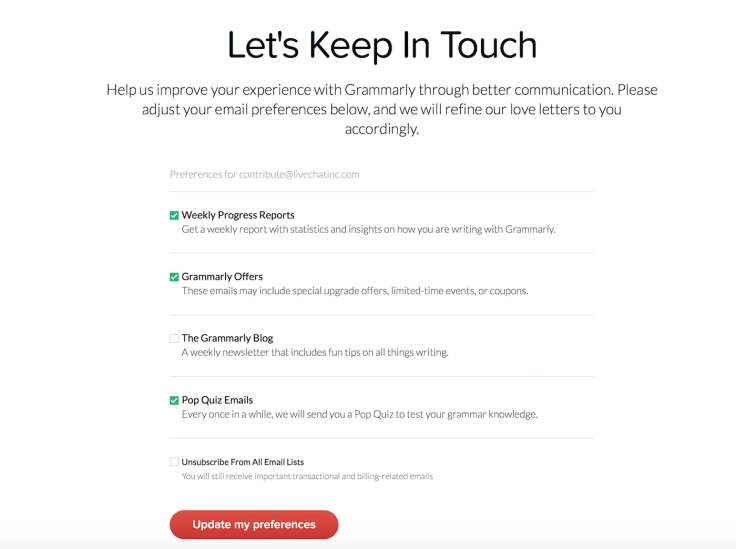
Looking for more inspiration? Check out these email drip campaign examples to help inspire yours.
How to Set Up a Drip Campaign
To get started with a successful drip campaign, you’ll need to have the right marketing automation software. This is what lets you choose your conditions for the drip campaign, create your messages, and monitor your results.
For this example, we’ll use Wishpond to set up a basic drip sequence. Start by choosing to create a new email automation campaign.

Step 1: Choose Your Campaign Type
Start by establishing what kind of drip campaign you will be running, and choose the right type of campaign.
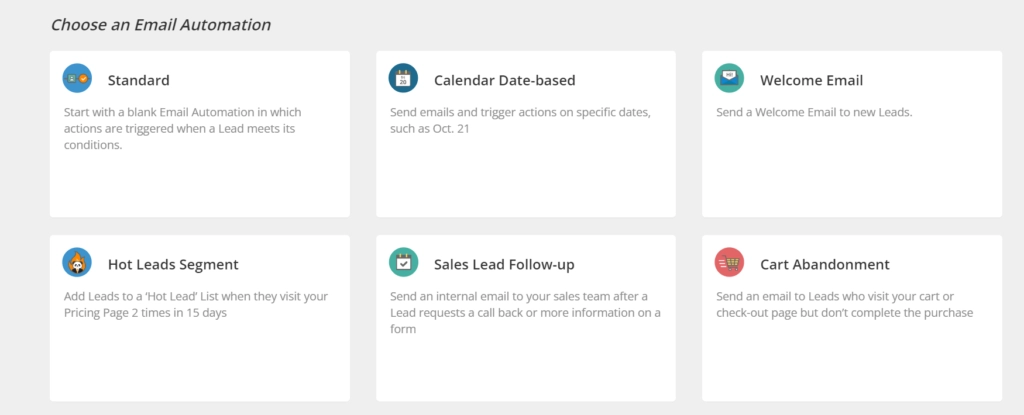
For this simple drip campaign example, we’ll choose a standard campaign.
Step 2: Set Your Conditions
The next step is to choose the conditions that will trigger your drip campaign. You could start the campaign for people who signed up on a specific page, who are part of a specific list, who bought a certain product, or more.
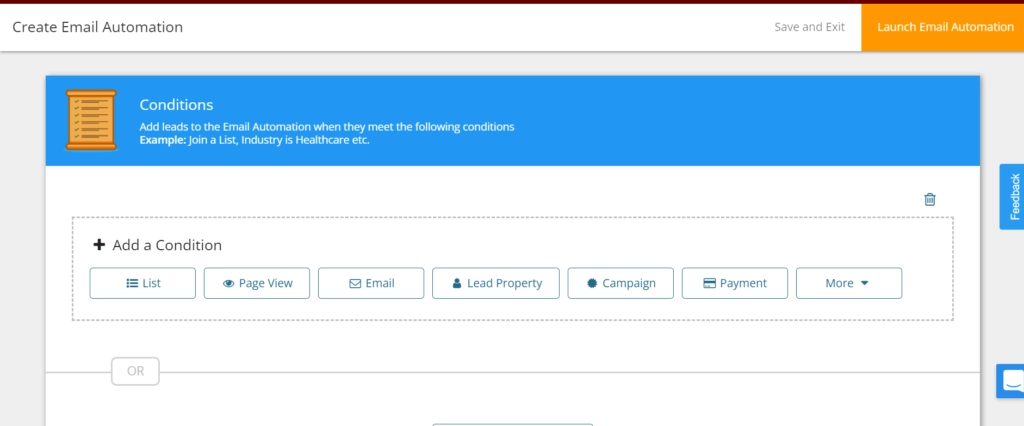
For this campaign, we’ll send the email to anyone who converted on a particular bottom bar popup.
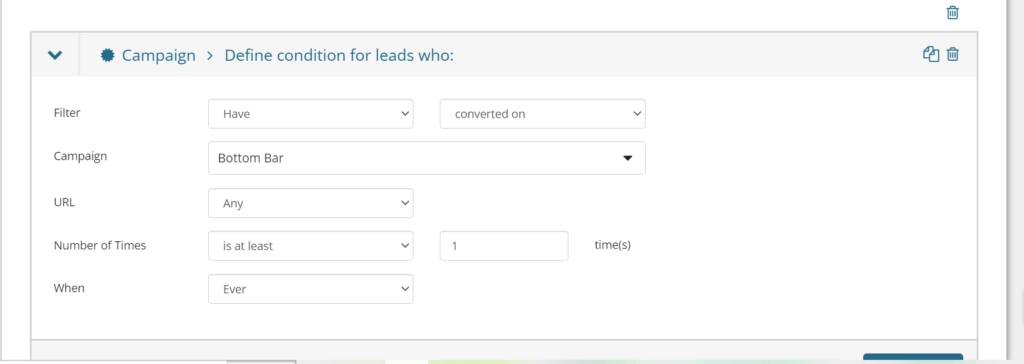
Step 3: Set the Action
Next, we need to choose what action we will take after the visitor converts on the bottom bar popup. This could be adding them to a list, targeting them with a message, or more.

For this drip campaign example, we will send them an email.
I have already prepared the email in our email marketing platform, which I labeled as “Email drip – educational-1”. This is the first message they get, which is automatically sent as soon as they convert on the popup. This is an educational email, so it shares interesting content relevant to the popup.

Step 4: Plan Out the Drip Sequence
Now you can customize your drip campaign and add additional steps. Maybe you want to send leads to a list if they clicked on your email, or maybe you want to send them another email. There are many different options.
For this example, we’ll send a second email, which is the second step in the educational drip sequence:

Once this is loaded up, we set the delivery window period. Our leads will receive the email at 9am on Monday:

Now, we continue to map out the drip sequence like this until we have added enough steps.
You can add as many steps, or sequences, as you want. You can also make it as complex or straightforward as you want. This is a very simple drip campaign example, but it should give you an idea of what you can achieve with these campaigns.
A good way to end the drip campaign is to add your leads at the end to a specific email list.
Step 5: Review the Results
Once your drip campaign is set up, you can leave it to do its thing while you go about your job. That’s the beauty of marketing automation.
After some time, check up on the drip sequence and see how it’s doing. You should be able to access information like how many clicks and opens you received on each email, what your deliverability looks like, and how many leads you generated from the campaign.
Your live campaign would look like this in the dashboard:

Now you can edit the drip campaign, deactivate it, or keep it running until you reach your objective.
Here are a few email drip templates you can follow to help you get started with your campaign.
Conclusion
Setting up a drip campaign is not as complicated as you might think. You just need to establish a goal, create your messages, and then let automation do the work for you. The right drip campaign software will add a whole new dimension to your marketing activity, without you having to do any work.
Drip emails can help you achieve many different things. They allow you to automate highly targeted, specific messages, and they require hardly any time or effort from you to set it up.
If you’re interested in getting started with a drip campaign, then book a time with us to see how you can create drip campaigns that grow your business.
Related Content
- B2B Email Drip Campaign Ideas and Examples
- 5 Drip Email Templates That Work
- 5 Ways our Clients Use Marketing Automation To Simplify Success
- What is Lead Scoring? 3 Examples to Help You Get Started
- The 5-Minute Guide to Optimizing for Email Automation Success

